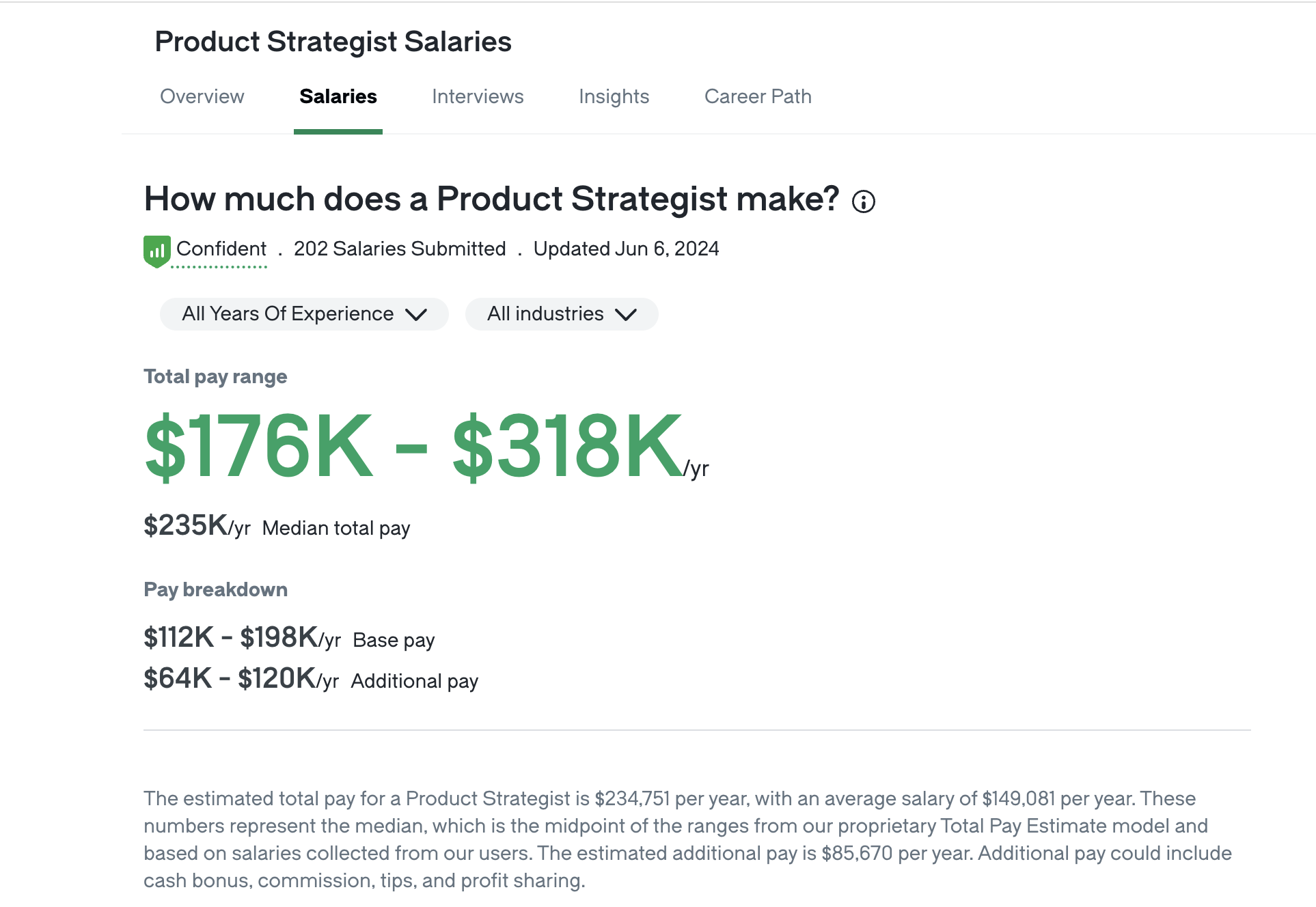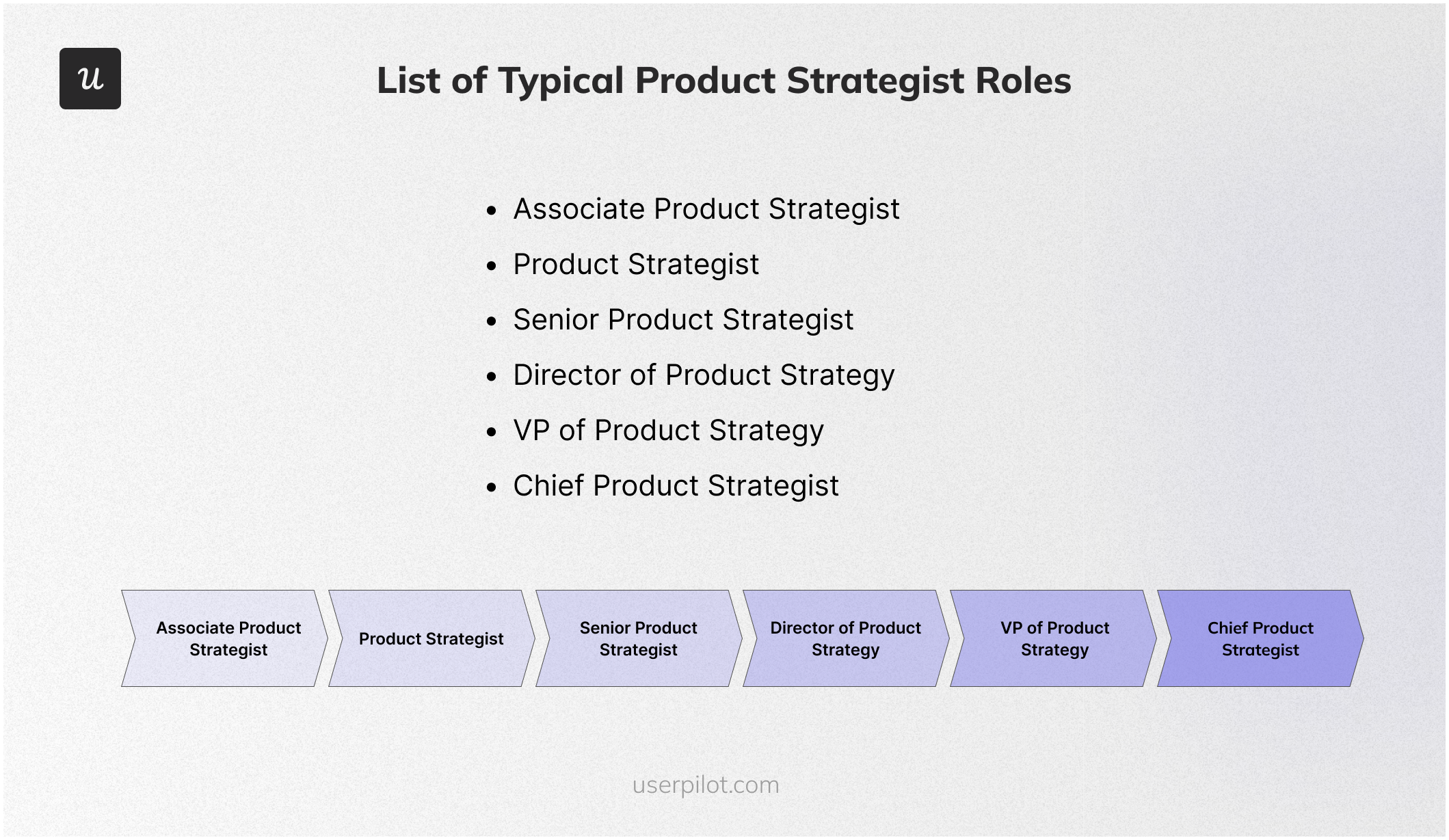
Try Userpilot Now
See Why 1,000+ Teams Choose Userpilot

Product strategist career path – quick summary
- A product strategist is responsible for working with a team of Product Managers to develop a comprehensive product strategy, product vision, and long-term roadmap that aligns with the company’s business objectives and market opportunities.
- Product strategists play a critical role in setting the company up for long-term success in the highly competitive SaaS market by driving innovation, and differentiation.
- One of the biggest factors influencing your salary is your experience level. Here’s how experience can impact your product strategist salary, according to Glassdoor:
- 1 to 3 years: $93,662/year
- 4-6 years: $111,071/year
- 7-9 years: $118,642/year
- 10-14 years: $129,350/year
- 15+ years: $143,936/year
- Here’s what a typical career path for a product strategist looks like:
- Associate Product Strategist: Collaborate with senior strategists to analyze market trends, gather customer insights, and develop product roadmaps. To progress, you demonstrate strong analytical skills, strategic thinking, and the ability to translate insights into actionable recommendations.
- Product Strategist: You will conduct in-depth market and competitive analyses, identify growth opportunities, and shape product strategy. You advance by consistently delivering data-driven strategies that drive product success and align with company objectives.
- Senior Product Strategist: You lead a team of strategists, mentor junior members, and orchestrate the development of comprehensive product strategies. You progress by showcasing exceptional leadership, strategic vision, and the ability to navigate complex challenges.
- Director of Product Strategy: You oversee the product strategy function, align strategies across multiple product lines, and ensure alignment with overall business goals. You advance by driving significant improvements in strategy execution, fostering cross-functional collaboration, and delivering measurable business impact.
- VP of Product Strategy: A VP of product strategy provides high-level executive guidance on product strategy, represents the strategic vision to stakeholders, and influences company-wide strategic decisions. You progress by demonstrating a deep understanding of market dynamics, anticipating industry trends, and driving innovation that fuels business growth.
- Chief Product Strategist: As a chief product strategist, you will serve as the highest-ranking executive responsible for shaping the company’s overall product strategy and ensuring alignment across all divisions. You advance by consistently delivering visionary strategies that drive long-term success and position the company as a market leader.
- As a product strategist, you’ll need tools that specifically support your responsibilities in developing and executing product strategies. Here’s a focused list of tools from the provided options that align with your core duties:
- Best tool for product management – Confluence: This collaboration and documentation platform enables product strategists to create and share product strategy documents and business case analyses with stakeholders.
- Best tool for product and user insights – Userpilot: An all-in-one product platform that comes with both engagement and analytics features (i.e. charts, surveys, event-tracking, etc. ) that can empower product teams to create engaging, user-centric experiences while leveraging data-driven insights to continually refine and enhance their products
- Best tool for UX/UI Design – Sketch: Sketch is a vector-based design tool that empowers product strategists to create and iterate on product concepts and wireframes.
- Best tools for customer experience management – Zoho Desk: Zoho Desk is a customer service platform that enables product strategists to monitor and analyze customer feedback, sentiment, and support trends. By leveraging this tool, you can gain valuable insights into customer needs and pain points, informing your product strategy and prioritization decisions.
- Best tool for task management – Asana: This tool helps you stay organized, track the progress of your team, and monitor deadlines.
- Looking into tools for product strategists? Userpilot is an all-in-one product platform with engagement features and powerful analytics capabilities. Book a demo to see it in action!
What is a product strategist?
A product strategist is responsible for working with a team of Product Managers to develop a comprehensive product strategy, product vision, and long-term roadmap that aligns with the company’s business objectives and market opportunities.
What does a product strategist do?
Product strategists play a critical role in setting the company up for long-term success in the highly competitive SaaS market by driving innovation, and differentiation.
They are in charge of developing comprehensive strategic plans and roadmaps for future product offerings. They collaborate with product managers, engineering, and other stakeholders to ensure the successful execution of product strategies.
Product strategist’s main responsibilities
A Product Strategist is responsible for the high-level planning of a product’s vision and strategies. Let’s take a closer look at their main responsibilities and duties.
- Conduct market research: A product strategist dives deep into market trends, competitor analysis, and user behavior to identify untapped opportunities.
- Define product strategy: Product strategists translate insights into a comprehensive product strategy that outlines key objectives, target segments, value propositions, and growth plans.
- Communicate product vision: Articulate the product strategy and vision to internal and external stakeholders, building alignment, enthusiasm, and support for SaaS initiatives.
- Identify partnership opportunities: A product strategist’s responsibility involves researching potential partnerships to extend product reach or capabilities.
- Prioritize features and roadmap: Collaborate with cross-functional teams to prioritize product features, balancing user needs, technical feasibility, and business impact to create a robust roadmap for SaaS development.
- Promote cross-team collaboration: Product strategists work with cross-functional teams, like product managers, engineers, marketers, and sales teams, to execute the product strategy.
- Analyze product performance: Monitor and analyze key performance indicators (KPIs) to gauge the success of SaaS products, identify areas for improvement, and make data-driven recommendations for optimization.
Product strategist salary
One of the biggest factors influencing your salary is your experience level. Here’s how experience can impact your product strategist salary, according to Glassdoor:
- 1 to 3 years: $93,662/year
- 4-6 years: $111,071/year
- 7-9 years: $118,642/year
- 10-14 years: $129,350/year
- 15+ years: $143,936/year
Industries where the demand for data professionals is highest tend to be the same industries that pay the most on average: Technology, Software-as-a-Service (SaaS), E-commerce, Financial Technology (FinTech), Healthcare Technology, Artificial Intelligence (AI) and Machine Learning (ML), Internet of Things (IoT), Telecommunications, Automotive (particularly in connected and autonomous vehicles), and Consumer Electronics.
Where you live can have a big impact on how much you make as a product strategist. As more and more companies employ a geographically dispersed workforce (including remote workers), it’s common for companies to offer location-based salaries. According to Glassdoor, these are the midpoint salaries for product strategists in the following large US cities:
- San Francisco: $145,713/year
- New York: $125,863/year
- Boston: $116,319/year
- Washington, DC: $119,038/year
- Chicago: $110,259/year
Product strategist career path
- Associate Product Strategist: Collaborate with senior strategists to analyze market trends, gather customer insights, and develop product roadmaps. To progress, you demonstrate strong analytical skills, strategic thinking, and the ability to translate insights into actionable recommendations.
- Product Strategist: You will conduct in-depth market and competitive analyses, identify growth opportunities, and shape product strategy. You advance by consistently delivering data-driven strategies that drive product success and align with company objectives.
- Senior Product Strategist: You lead a team of strategists, mentor junior members, and orchestrate the development of comprehensive product strategies. You progress by showcasing exceptional leadership, strategic vision, and the ability to navigate complex challenges.
- Director of Product Strategy: You oversee the product strategy function, align strategies across multiple product lines, and ensure alignment with overall business goals. You advance by driving significant improvements in strategy execution, fostering cross-functional collaboration, and delivering measurable business impact.
- VP of Product Strategy: A VP of product strategy provides high-level executive guidance on product strategy, represents the strategic vision to stakeholders, and influences company-wide strategic decisions. You progress by demonstrating a deep understanding of market dynamics, anticipating industry trends, and driving innovation that fuels business growth.
- Chief Product Strategist: As a chief product strategist, you will serve as the highest-ranking executive responsible for shaping the company’s overall product strategy and ensuring alignment across all divisions. You advance by consistently delivering visionary strategies that drive long-term success and position the company as a market leader.
How to become a product strategist
Here are the main steps for becoming a product strategist:
- Get a degree: At a minimum, you’ll need to obtain a bachelor’s degree in business administration, management, computer science, or a related field. An MBA could be preferred for senior-level positions, although it is not always required.
- Certification: Enhance your education with a specialized certification such as the Product Strategy certification offered by the Association of International Product Marketing and Management (AIPMM).
- Gain essential skills: You need to work on your soft and hard skills to make a great product strategist. These skills include data analytics, marketing, technical knowledge in CRM systems, agile methodologies, and so on.
- Develop a portfolio: Get involved with hands-on projects and enroll in internships to get real-life experience of what the job entails.
Best resources for product strategists
There are a gazillion resources out there for product strategists to study and increase their knowledge of their skills. Here’s a bulleted list of the best resources for product strategists ranging from books, webinars, podcasts, and blogs:
Best books for product strategists
- Inspired: How to Create Tech Products Customers Love” by Marty Cagan: This book is a comprehensive guide to creating successful products, focusing on the importance of customer-centric design and effective product management strategies.
- The Lean Product Playbook: How to Innovate with Minimum Viable Products and Rapid Customer Feedback” by Dan Olsen: This book provides a step-by-step approach to building products that resonate with customers, using the Lean Startup methodology and rapid iterations based on customer feedback.
- Hooked: How to Build Habit-Forming Products by Nir Eyal: Eyal explores the psychology behind creating products that engage users and form long-lasting habits, providing valuable insights for product strategists looking to increase user retention and loyalty.
- The Innovator’s Dilemma: When New Technologies Cause Great Firms to Fail” by Clayton M. Christensen: A groundbreaking book that examines why established companies often struggle to adapt to disruptive technologies, offering lessons for product strategists on how to navigate innovation and stay ahead of the curve.
Best webinars for product strategists
Staying ahead of the curve in product strategy is crucial for success. Webinars offer a convenient and informative way to learn from industry leaders and enhance your skill set. Here’s a curated list of top webinar sources specifically tailored for product strategists:
- Userpilot Events focuses on product growth and user onboarding, which are crucial elements of successful product strategies. Their webinars offer valuable insights on user experience optimization, feature adoption, and user engagement strategies – all directly impacting your product strategy decisions.
- ProductPlan provides webinars on product strategy frameworks, prioritization techniques, and creating a product roadmap that aligns with business goals.
- CB Insights is a leading market research firm. They host webinars on emerging trends in various industries, which can be valuable for product strategists when conducting market research
Best blogs for product strategists
- Product management blog by Userpilot: From guides to listicles, this blog has hundreds of articles on product management in the SaaS industry.
- SVPG blog: Marty Cagan founded the Silicon Valley Product Group (SVPG) to share his knowledge and experience with product leaders. Follow this blog and you will learn it all.
- Product Talk: Teresa Torres and her team highlight teachings from her reputable book (Product Discovery Habits) to help product teams build valuable products.
- Product Manager HQ: The Product Manager HQ blog explains essential product management concepts, offering valuable insights and practical guidance to newbie product managers.
- Bring the donuts: A well-known product professional (Ken Norton) offers the best articles in the product strategy realm.
Best podcasts for product strategists
- Masters of Scale” hosted by Reid Hoffman: In this podcast, LinkedIn co-founder Reid Hoffman interviews successful entrepreneurs and business leaders, providing valuable insights on scaling products and building innovative companies.
- The Product Podcast hosted by Rajesh Nerlikar: This podcast features interviews with product leaders from various industries, covering topics such as product strategy, user research, and product-market fit.
- How I Built This hosted by Guy Raz: Guy Raz interviews founders of successful companies, offering inspiring stories and lessons learned that can inform product strategists as they navigate the challenges of building and growing products.
- Mind the Product by Lily Smith and Robin Zander: The official podcast of the Mind the Product community, this show features interviews with product experts and practitioners, covering a wide range of topics relevant to product strategists.
Best tools for product strategists
As a product strategist, you’ll need tools that specifically support your responsibilities in developing and executing product strategies. Here’s a focused list of tools from the provided options that align with your core duties:
- Best tool for product management – Confluence: This collaboration and documentation platform enables product strategists to create and share product strategy documents and business case analyses with stakeholders.
- Best tool for product and user insights – Userpilot: An all-in-one product platform that comes with both engagement and analytics features (i.e. charts, surveys, event-tracking, etc. ) that can empower product teams to create engaging, user-centric experiences while leveraging data-driven insights to continually refine and enhance their products
- Best tool for UX/UI Design – Sketch: Sketch is a vector-based design tool that empowers product strategists to create and iterate on product concepts and wireframes.
- Best tools for customer experience management – Zoho Desk: Zoho Desk is a customer service platform that enables product strategists to monitor and analyze customer feedback, sentiment, and support trends. By leveraging this tool, you can gain valuable insights into customer needs and pain points, informing your product strategy and prioritization decisions.
- Best tool for task management – Asana: This tool helps you stay organized, track the progress of your team, and monitor deadlines.
Conclusion
We hope our article has given you a good overview of the career path for product strategists. Whether you’re just starting out or looking to advance, the key is to stay curious, keep learning, and remain open to new opportunities along the way.
Looking into tools for product strategists? Userpilot is an all-in-one product platform with engagement features and powerful analytics capabilities. Book a demo to see it in action!









